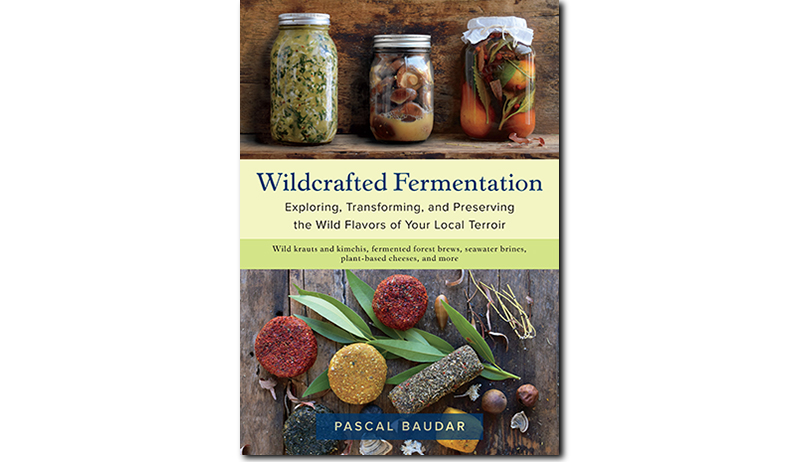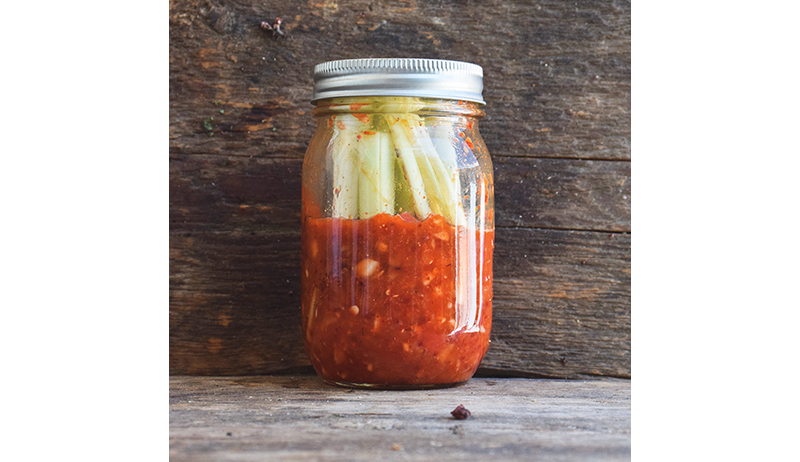
This excerpt is from Pascal Baudar’s book Wildcrafted Fermentation: Exploring, Transforming, and Preserving the Wild Flavors of Your Local Terroir (Chelsea Green Publishing, March 2020) and is reprinted with permission from the publisher.
Fermenting with Spice Blends
A few years back I had no idea how to make my own spice blend. Like most people I would purchase my favorite ones at the store, but it never occurred to me that the process was quite simple.
I mean, it’s not that obvious: You basically purchase some colored powder or odd mix of herby bits and it makes food taste great. It’s quite magical! Somehow I had the (mis)conception that creating this magic powder was a very esoteric process requiring some sort of obscure knowledge, huge amounts of herbal enlightenment, possibly incantations and a master’s degree from the Hogwarts School of Witchcraft and Wizardry.
It wasn’t until I started researching and making my own spice blends using local wild herbs and aromatic seeds that I understood how simple the process can be. I also learned that, with a bit of practice and experimentation, you can create blends much more delicious than whatever you can purchase at the store. The reason is quite simple: By making your own blends, you can adjust the ingredients to your own taste buds, and with practice it becomes a highly intuitive endeavor based on your savory preferences.
I’m not saying that you must absolutely make your own blends. There are quite a few wonderful commercial blends out there! Some are so delicious that I’m still trying to deconstruct them, which isn’t always an easy task. (Maybe they do use incantations!)
Being active in several online fermenting groups, I think not enough fermenters are taking advantage of the possibilities. A good blend can really elevate your regular ferments to new levels—sauerkrauts, kimchis, or even mixed vegetables. It doesn’t have to be complicated at all: Last week I made a sort of kimchi using a barbecue spice blend as flavoring instead of the regular chili powder, garlic, and ginger. As a result the smoky/sweet flavors made the ferment incredibly tasty, and I’m not even sure if I can still call it a kimchi.
Mixing spice blends with fermented wild edibles is even more exciting. Not only are you experimenting with new savory ingredients in the first place, but by flavoring them with various blends, you can multiply the creative culinary possibilities indefinitely. A new world of tasty fermented condiments waits to be explored.
Don’t hesitate to experiment with regular ingredients. I could probably write a whole book on just fermenting cabbage with various spice blends and aromatic herbs.
But let’s start with a simple blend using spices that can already be found in your kitchen or the local supermarket. The method is really not elaborate, and in this case we’re not even using dried herbs, tough roots, or seeds. All the ingredients can be purchased in the form of powders or granules (sugar).
If you have to deal with ingredients requiring grinding, you can easily use a coffee grinder, a Vitamix (for larger quantities), or—like me—a stone grinder. There is something primal and feral in stone-ground spices; it seems to be ingrained in our DNA. I can imagine one of my ancestors doing exactly the same thing to flavor a dish thousands of years ago. Doing it by hand, you also have more control over the “roughness” of the final product.
Never take an existing recipe as the last word, by the way: A spice blend should be your own personal creation. You can move stuff around, find substitutes, and add other things that you like or think would work. If it wasn’t a good idea, you just learned something. Cherish the mistakes; with time and experience you can become a spice Jedi and—who knows?—maybe make a fortune selling your own “secret” blend.
Read more: Read our reviewer’s thoughts about Wildcrafted Fermentation.
Wild Food Kimchi
Well, sorta wild … basically I use locally foraged mustard and wild radish leaves fermented with chili flakes/powder and garlic, but you also use some regular sugary ingredients like bok choy, napa cabbage, or regular cabbage. In this version I also add some sliced wild turnip (a variant of Brassica rapa) roots.
Because of seasonality and location, you can’t really make the same recipe twice, so this is again a concept recipe. If I were in Belgium, I could do something similar, but with different wild plants. You are looking at a ratio of around 30 percent wildcrafted ingredients and 70 percent regular stuff. Of course, you can experiment and decide to use many more wild edibles.
Ingredients for a 1-quart jar (946 ml)
- 12 ounces (300 g) bok choy leaves
- 4 ounces (110 g) regular cabbage, shredded
- Salt
- 4 ounces (110 g) mustard and radish leaves
- 1 ounce (30 g) curly dock leaves
- 2 ounces (60 g) wild turnip roots
- 6 garlic cloves
- 2–4 tablespoons (15–30 g) mild chili flakes
- 1 teaspoon (3 g) spicy chili flakes
- ⅓ cup (78 ml) water
Procedure
The total weight ended up at a bit more than 1 pound 11 ounces (765 g). I used 3½ teaspoons (20 g) of salt.
- I use a method similar to that for making sauerkraut. First, I place the bok choy and cabbage in a bowl, add the salt, and massage the ingredients tenderly for 10 minutes. I let the contents rest for 10 minutes then repeat twice until it is tender. I end up with a decent amount of brine.
- Meanwhile I cut all my wild greens leaves in thin strips (chiffonade cut), thinly slice the turnip roots, mince the garlic, and get all my other ingredients ready.
- Place everything into the bowl including the spices, then add the water and with your hands (wear gloves) massage the contents one more time for 3 to 4 minutes until “juicy.”
- Transfer the “kimchi” to a jar to ferment for 3 to 4 days at room temperature. Burp as necessary and stir the contents at least once a day. Then place your jar in the fridge to age and continue fermenting slowly. It will last for months.
Serve it as a condiment or mixed in a wild food salad. Heck, I’ve been known to blend it into a paste and use it as a kind of hot sauce.
This recipe is super good for the environment, too, since all the wild plants I used are non-native and invasive.
Fermented Cattail Shoot Hearts in Spicy Sauce
I had the most interesting experience collecting cattail shoots. I didn’t know rattlesnakes could swim in shallow water. I was minding my own business standing in the water when I saw a beautiful snake coming down the stream toward me. There was no time to do anything, so I just froze. The snake passed by dangerously close without paying much attention. Scared the hell out of me, but it’s all good! The snake and I shook hands (metaphorically speaking) and we’re friends now.
That morning I collected around 12 young, tender cattail shoots in a pristine stream. Once home, I soaked them for an hour or so in two or three changes of water. (The original stream was pretty pure, but I’m a nut about food safety.) If you do this, you may need a weight to keep the shoots under the water, as they tend to float.
Next, remove the stringy outside layers to get to the tender heart. Cut them to a bit less than the height of a pint jar and set aside.
I like to ferment sizable shoots so I can cut them later on to whatever size I want; I use them with some of my wild food salads and various other dishes.
This time I fermented them in a very spicy hot sauce. To make the sauce, mix the ingredients in your blender. You can make a thin or rough paste.
Ingredients for a pint jar (475 ml)
- 8–10 garlic cloves, chopped
- 2–4 habanero peppers (4 if you like the heat)
- 1 medium red bell pepper, chopped
- ½ cup (118 ml) water
- ½ teaspoon (1.5 g) minced shallot or red onion
- About 12 cattail shoots
- 2 tablespoons (12 g) mild red pepper powder
- 1 teaspoon (2.5 g) smoked jalapeño powder (chile morita or chipotle)
- ½ teaspoon (1 g) ginger powder
- ½ teaspoon (1 g) curry powder or Curry Blend
Salt Procedure
Process the garlic, habaneros, bell pepper, water, and shallot in a blender. Remove the mixture to a bowl and mix with the cattail shoots. Add the spices, massage gently for a few seconds, then transfer everything into a pint jar. I ended up with 10 ounces (283 g) and used 2¼ teaspoons (12.5 g) of salt, so the end result was superhot and salty, too. The heat of the sauce will go down a bit with fermentation, but it will still hurt. If you really don’t like a sauce that’s too hot, just use 1 habanero.
The cattail shoots will be fairly loose in the jar and not under the brine. Close the lid but not too tight; you want fermentation gases to escape. Around three times a day, close the lid tight, shake the jar gently, then unscrew the lid a bit. Another option is to close the jar, shake daily, and burp as necessary. When the initial fermentation is complete (around 10 days), place the jar in the fridge for further aging.
This type of ferment and recipe can also be used with mustard stems, wild asparagus, ramps, stems, and tender roots as well as regular ingredients like carrot strips, daikon slices, cauliflower, and sliced beets.





